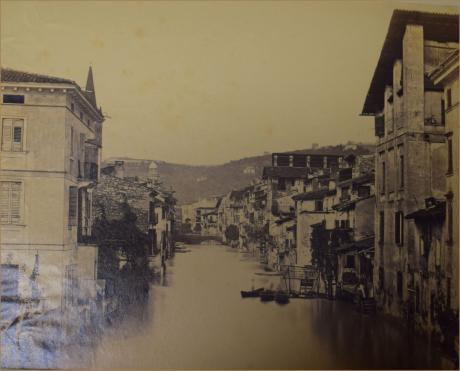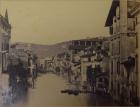The precise details of Verona's early history remain a mystery. One theory is it was a city of the Euganei, who were obliged to give it up to the Cenomani (550 BC). With the conquest of the Valley of the Po, the Veronese territory became Roman (about 300 BC). Verona became a Roman colonia in 89 BC. It was classified as a municipium in 49 BC, when its citizens were ascribed to the Roman tribe Poblilia or Publicia.
The city became important because it was at the intersection of several roads. Stilicho defeated Alaric and his Visigoths here in 403. But, after Verona was conquered by the Ostrogoths in 489, the Gothic domination of Italy began. Theoderic the Great was said to have built a palace there. It remained under the power of the Goths throughout the Gothic War (535–552), except for a single day in 541, when the Byzantine officer Artabazes made an entrance. The defections that took place among the Byzantine generals with regard to the booty made it possible for the Goths to regain possession of the city. In 552 Valerian vainly endeavored to enter the city, but it was only when the Goths were fully overthrown that they surrendered it.
In 569, it was taken by Alboin, King of the Lombards, in whose kingdom it was, in a sense, the second most important city. There, Alboin was killed by his wife in 572. The dukes of Treviso often resided there. Adalgisus, son of Desiderius, in 774 made his last desperate resistance in Verona to Charlemagne, who had destroyed the Lombard kingdom. Verona became the ordinary residence of the kings of Italy, the government of the city becoming hereditary in the family of Count Milo, progenitor of the counts of San Bonifacio. From 880 to 951 the two Berengarii resided there. Otto I ceded to Verona the marquisate dependent on the Duchy of Bavaria.
When Ezzelino III da Romano was elected podestà in 1226, he converted the office into a permanent lordship. In 1257 he caused the slaughter of 11,000 Paduans on the plain of Verona (Campi di Verona). Upon his death, the Great Council elected Mastino I della Scala as podestà, and he converted the "signoria" into a family possession, though leaving the burghers a share in the government. Failing to be re-elected podestà in 1262, he effected a coup d'état, and was acclaimed capitano del popolo, with the command of the communal troops. Long internal discord took place before he succeeded in establishing this new office, to which was attached the function of confirming the podestà. In 1277, Mastino della Scala was killed by the faction of the nobles.
The reign of his son Alberto as capitano (1277–1302) was a time of incessant war against the counts of San Bonifacio, who were aided by the House of Este. Of his sons, Bartolomeo, Alboino and Cangrande I, only the last shared the government (1308); he was great as warrior, prince, and patron of the arts; he protected Dante, Petrarch, and Giotto. By war or treaty, he brought under his control the cities of Padua (1328), Treviso (1308) and Vicenza. At this time before the Black death the city was home to more than 40,000 people.
Cangrande was succeeded by Mastino II (1329–1351) and Alberto, sons of Alboino. Mastino continued his uncle's policy, conquering Brescia in 1332 and carrying his power beyond the Po. He purchased Parma (1335) and Lucca (1339). After the King of France, he was the richest prince of his time. But a powerful league was formed against him in 1337 – Florence, Venice, the Visconti, the Este, and the Gonzaga. After a three years war, the Scaliger dominions were reduced to Verona and Vicenza (Mastino's daughter Regina-Beatrice della Scala married to Barnabò Visconti). Mastino's son Cangrande II (1351–1359) was a cruel, dissolute, and suspicious tyrant; not trusting his own subjects, he surrounded himself with Brandenburg mercenaries. He was killed by his brother Cansignorio (1359–1375), who beautified the city with palaces, provided it with aqueducts and bridges, and founded the state treasury. He also killed his other brother, Paolo Alboino. Fratricide seems to have become a family custom, for Antonio (1375–87), Cansignorio's natural brother, slew his brother Bartolomeo, thereby arousing the indignation of the people, who deserted him when Gian Galeazzo Visconti of Milan made war on him. Having exhausted all his resources, he fled from Verona at midnight (19 October 1387), thus putting an end to the Scaliger domination, which, however, survived in its monuments.
The year 1387 is also the year of the Battle of Castagnaro, between Giovanni Ordelaffi, for Verona, and John Hawkwood, for Padua, who was the winner.
Antonio's son Canfrancesco attempted in vain to recover Verona (1390). Guglielmo (1404), natural son of Cangrande II, was more fortunate; with the support of the people, he drove out the Milanese, but he died ten days after, and Verona then submitted to Venice (1405). The last representatives of the Scaligeri lived at the imperial court and repeatedly attempted to recover Verona by the aid of popular risings.
From 1508 to 1517, the city was in the power of the Emperor Maximilian I. There were numerous outbreaks of the plague, and in 1629–33 Italy was struck by its worst outbreak in modern times. Around 33,000 people died in Verona (over 60 per cent of the population at the time) in 1630–1631.
In 1776 was developed a method of bellringing called Veronese bellringing art. Verona was occupied by Napoleon in 1797, but on Easter Monday the populace rose and drove out the French. It was then that Napoleon made an end of the Venetian Republic. Verona became Austrian territory when Napoleon signed the Treaty of Campo Formio in October 1797. The Austrians took control of the city on 18 January 1798. It was taken from Austria by the Treaty of Pressburg in 1805 and became part of Napoleon's Kingdom of Italy, but was returned to Austria following Napoleon's defeat in 1814, when it became part of the Austrian-held Kingdom of Lombardy-Venetia.
The Congress of Verona, which met on 20 October 1822, was part of the series of international conferences or congresses, opening with the Congress of Vienna in 1814–15, that marked the effective breakdown of the "Concert of Europe".
In 1866, following the Third Italian War of Independence, Verona, along with the rest of Venetia, became part of United Italy.
The advent of fascism added another dark chapter to the annals of Verona. As throughout Italy, the Jewish population was hit by the Manifesto of Race, a series of anti-Semitic laws passed in 1938, and after the invasion by Nazi Germany in 1943, deportations to Nazi concentration camps. An Austrian Fort (now a church, the Santuario della Madonna di Lourdes), was used to incarcerate and torture Allied troops, Jews and anti-fascists, especially after 1943, when Verona became part of the Italian Social Republic.
As in Austrian times, Verona became of great strategic importance to the regime. Galeazzo Ciano, Benito Mussolini's son-in-law, was accused of plotting against the republic; in a show trial staged in January 1944 by the Nazi and fascist hierarchy at Castelvecchio (the Verona trial), Ciano was executed on the banks of the Adige with many other officers on what is today Via Colombo. This marked another turning point in the escalation of violence that would only end with the final liberation by allied troops and partisans in 1945.
After World War II, as Italy entered into NATO, Verona once again acquired its strategic importance, due to its closeness to the Iron Curtain. The city became the seat of SETAF (South European Allied Terrestrial Forces) and had during the whole duration of the Cold War period a strong military presence, especially American, which is decreasing only in these recent years. Now Verona is an important and dynamic city, very active in terms of economy, and also a very important tourist attraction thanks to its history, where the Roman past lives side by side with the Middle Age Verona, which in some senses brings about its architectural and artistic motifs.


